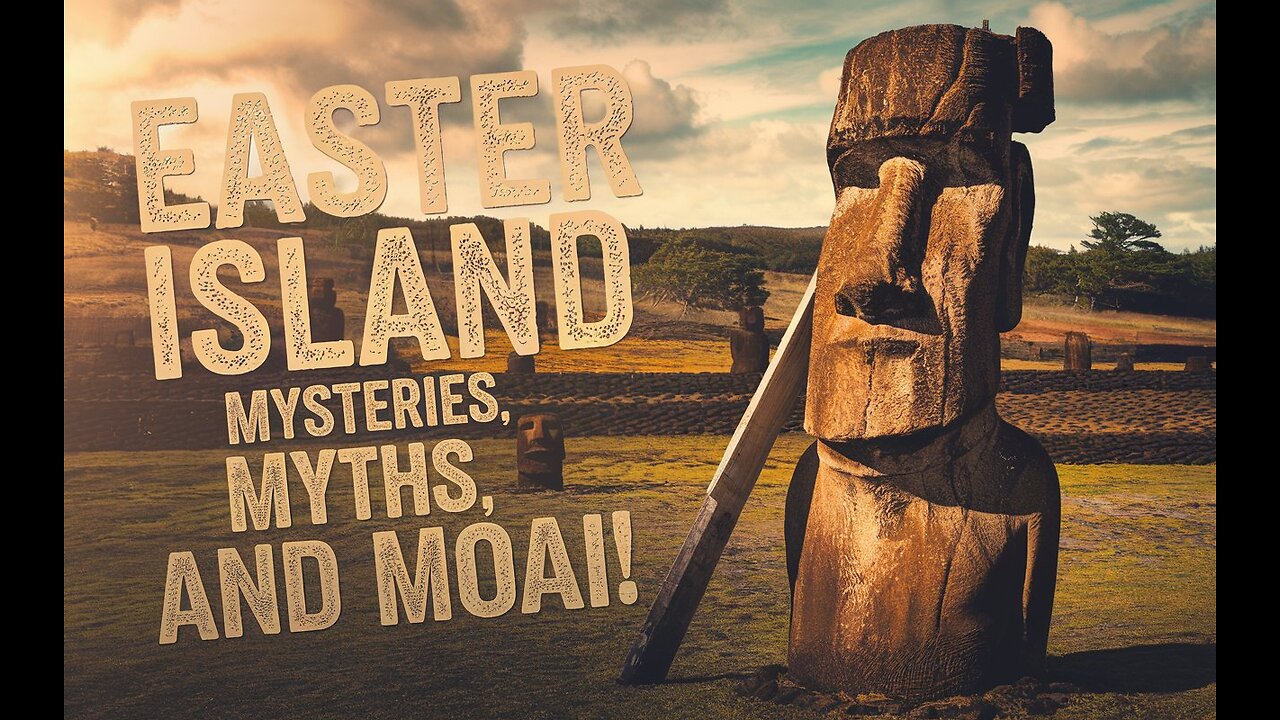Premium Only Content

Easter Island_ Mysteries, Myths, and Moai
Easter Island_ Mysteries, Myths, and Moai
Discover the fascinating history of Easter Island in our latest video, "Easter Island: Mysteries, Myths, and Moai!" Uncover the secrets behind the iconic moai statues and explore the island’s rich cultural heritage. We delve into intriguing theories, from ancient alien visits to ecological collapse, that attempt to explain the island's enigmatic past. Join us as we separate fact from fiction and unveil the mysteries that surround this remote paradise. Whether you’re a history buff or just curious about world wonders, this video promises to entertain and inform! Don’t forget to like and share if you enjoyed the journey!
Easter Island, known locally as Rapa Nui, is a remote volcanic island in Polynesia, often considered one of the most isolated inhabited places on Earth. Here are some key points about Easter Island:
Geography and History:
Location**: It lies in the southeastern Pacific Ocean, about 3,700 kilometers (2,300 miles) from the nearest continental point in Chile, to which it administratively belongs.
- **Discovery and Settlement**: The island was colonized by Polynesians around 1200 AD. Europeans first encountered it on Easter Sunday in 1722, thus the name Easter Island by the Dutch explorer Jacob Roggeveen.
### Moai Statues:
- **Moai**: Easter Island is most famous for its monumental statues, called Moai. These are massive human figures carved by the Rapa Nui people from rock on the island's quarry.
- **Purpose**: The exact purpose of the Moai is still debated, but they are generally believed to represent deified ancestors who were believed to protect the island's clans.
- **Construction**: The largest Moai ever erected was over 30 feet tall and weighed about 82 tons. The process of carving, moving, and erecting these statues remains one of archaeology’s great mysteries.
### Cultural and Environmental Collapse:
- **Ecological Disaster**: The island's ecosystem collapsed due to deforestation, overpopulation, and the introduction of rats which ate seeds needed for tree regeneration. This led to a dramatic reduction in resources.
- **Societal Collapse**: The ecological disaster is believed to have contributed to a societal collapse, marked by warfare, cannibalism, and the toppling of the Moai, known as the 'Hurricanes' period.
### Modern Times:
- **Annexation by Chile**: In 1888, Easter Island was annexed by Chile, and today it remains a special territory of Chile.
- **Population**: Currently, the population consists of descendants of the original Rapa Nui people and some intermarriages with other Polynesians, Europeans, and Latin Americans. The population is around 7,750 people as of recent counts.
- **Tourism**: The island's economy heavily relies on tourism, with visitors coming to see the Moai, explore its unique culture, and enjoy its natural beauty. However, this has brought challenges regarding conservation and cultural preservation.
### Cultural Significance:
- **Rapa Nui Culture**: Despite its hardships, Rapa Nui culture remains vibrant, with traditional music, dance (like the Haka Pei), and crafts. Efforts are made to preserve the language, traditions, and heritage of the island.
- **UNESCO**: Easter Island was designated a UNESCO World Heritage Site in 1995, recognizing the cultural and environmental significance of the island.
Easter Island serves as a poignant reminder of how human activity can impact isolated ecosystems and has become a symbol in discussions about sustainability, cultural heritage, and environmental stewardship.
-
 DVR
DVR
The Rubin Report
1 hour agoBill Maher Makes Neil deGrasse Tyson Go Silent with His Proof of Failing Science
6.54K6 -
 LIVE
LIVE
Geeks + Gamers
1 hour agoDisney Still HIDING Snow White Trailer After Rachel Zegler BACKLASH, Wicked And Gladiator Box Office
1,529 watching -
 1:57:01
1:57:01
Steven Crowder
3 hours agoWill The Left Use The Ukraine War to Sabotage Trump's Presidency?
197K130 -
 LIVE
LIVE
Tudor Dixon
2 hours agoDudes Shouldn't be in Women's Bathrooms | The Tudor Dixon Podcast
215 watching -
 16:27
16:27
Dave Portnoy
3 hours agoDavey Day Trader Presented by Kraken - November 25, 2024
28.6K3 -
 1:27:43
1:27:43
Graham Allen
4 hours agoJoe Rogan Warns The World About WWIII! Make Military Great Again! + Elon Is Buying MSNBC?!
67.3K96 -
 LIVE
LIVE
Caleb Hammer
2 hours agoEntitled Gen-Z Girl Uses Payday Loans To Party | Financial Audit
272 watching -
 LIVE
LIVE
LFA TV
12 hours agoBUSTED! UKRAINE $$ LAUNDERING! | LIVE FROM AMERICA 11.25.24 11am EST
5,892 watching -
 LIVE
LIVE
LumpyPotatoX2
1 day agoGrayZone Warfare: NightOp - #RumbleGaming
405 watching -
 2:24:06
2:24:06
Matt Kohrs
13 hours agoStocks Pump Higher (RUM, MSTR & TSLA) || The MK Show
31.9K2